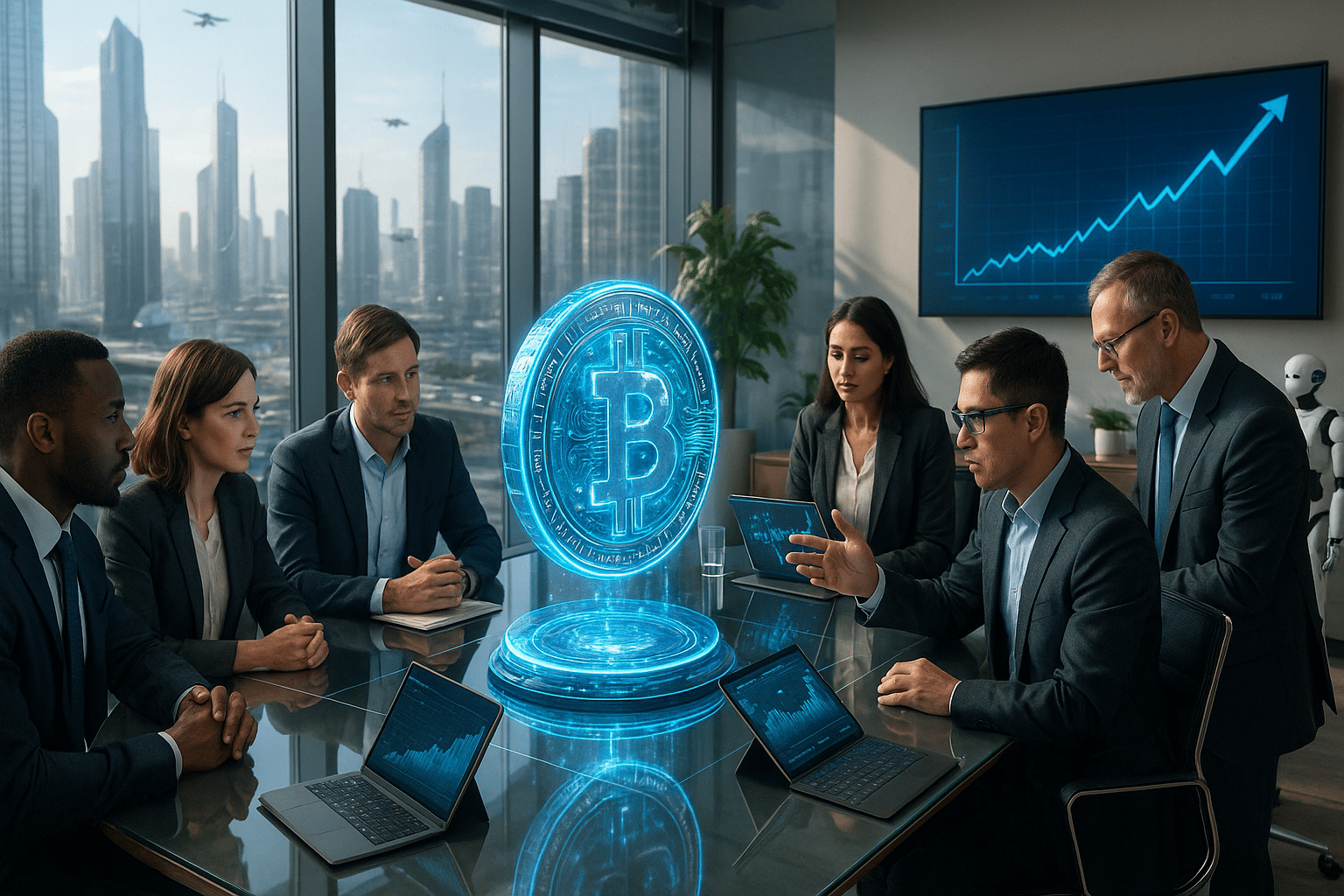Exciting, isn’t it? This is not a figment of a utopian future. It’s happening right now, with the rise of asset tokenization in the digital economy, the subject of our discourse today. 🌐💰
Asset tokenization, a relatively new entrant in the blockchain technology sphere, is paving the way for a revolution in how we perceive and handle valuable assets. It’s transforming the traditional economy, forging a more accessible, efficient, and decentralized financial ecosystem. In a nutshell, it’s a game-changer. 🎯
As you journey through this article, I aim to unravel the intricacies of asset tokenization, the technology underpinning it, and its transformative potential. An exciting journey awaits us, so buckle up and get ready to explore this brave new world of digitized assets.
Now, let’s set the stage for our exploration. You might be wondering, what exactly is asset tokenization? How does it work? And why is it essential in the digital economy? In the subsequent sections, we’ll delve deep into these questions, shedding light on the concept, the mechanics, and the significance of asset tokenization.
Asset tokenization, in simple terms, is the process of converting the rights to an asset into a digital token on a blockchain. This process democratizes access to a variety of assets and enables fractional ownership. But wait, there’s more to it than meets the eye.🔍
Under the hood of this simple definition, there’s a robust technology backbone that makes asset tokenization possible – Blockchain. We’ll take a look at how blockchain provides the ideal environment for tokenization, ensuring transparency, security, and immutability of transactions. But, it doesn’t end there.
One cannot talk about tokenization without touching upon the role of smart contracts. These self-executing contracts, with the terms of agreement directly written into lines of code, are the linchpin that holds the tokenization ecosystem together. We’ll uncover how smart contracts streamline the tokenization process, making it swift, automated, and error-free.⚡️
Then, we’ll shift our focus to exploring the myriad of benefits asset tokenization brings to the table. From increased liquidity and transparency to reduced costs and improved efficiency, the advantages are immense and far-reaching. To give you a clearer picture, we’ll illustrate these benefits with real-world examples and use-cases across industries.🚀
Finally, we’ll gaze into the crystal ball to foresee the future of asset tokenization. As more industries and businesses realize its potential, the role of tokenization in shaping the digital economy is becoming increasingly apparent. We’ll delve into the trends and developments that are likely to shape the future of this exciting technology.
As we embark on this voyage of discovery, I hope to provide you with a comprehensive understanding of asset tokenization, its workings, its benefits, and its future potential. So, whether you’re a seasoned blockchain enthusiast or a curious novice, there’s something in this article for everyone. Let’s begin our journey into the fascinating world of asset tokenization. 🚀
Exploring the Innovation: Asset Tokenization
The rise of asset tokenization is set to revolutionize how we perceive and manage assets in the digital economy. With the advent of blockchain technology and the increasing use of cryptocurrencies, the financial world is witnessing a paradigm shift in asset management and transaction processes. This article dives deep into the world of asset tokenization, its implications, benefits, and challenges.
So, what exactly is asset tokenization? It is the process of converting real-world assets into digital tokens on the blockchain. These tokens represent a certain amount of the underlying asset. This can range from tangible assets like real estate and artworks to intangible ones like patents and copyrights. Watch the video “Asset Tokenization Explained” by FinTech Explained on YouTube for a comprehensive understanding of this concept.
The process of tokenization brings in a great deal of flexibility and liquidity to the traditional asset market. Imagine owning a piece of a famous painting or a percentage of a lucrative real estate property without having to bear the entire cost. That’s the power of tokenization!
Comparing Traditional Assets and Tokenized Assets
Before we delve further into the advantages of asset tokenization, let’s compare traditional assets and tokenized assets. This comparison is crucial to understand the revolutionary changes that tokenization is bringing to the table.
| Traditional Assets | Tokenized Assets |
|---|---|
| Limited liquidity | High liquidity |
| High minimum investment | Low minimum investment |
| Difficult to transfer | Easy to transfer |
| Limited trading hours | 24/7 trading |
The above comparison clearly shows how asset tokenization is not only making assets more accessible but also more manageable. Furthermore, it’s making the trading process more efficient and democratized.
The Benefits of Asset Tokenization
The benefits of asset tokenization are multi-faceted and extend to different domains. Let’s discuss some of these advantages in detail.
Increased Liquidity
Tokenization brings previously illiquid assets to the marketplace. By dividing a high-value asset into smaller, more affordable tokens, more people can invest, thus boosting the liquidity of the asset.
Global Market Access
Tokenization has the potential to connect asset holders and investors globally. This eliminates geographical restrictions and opens up new investment opportunities for individuals around the world.
Transparency and Security
Blockchain technology ensures that every transaction is transparent and secure. This reduces the chances of fraud and gives all participants a clear view of the asset’s history and current status.
So, how do you get started with asset tokenization? Check out the YouTube video “Getting Started with Asset Tokenization” by Blockchain at Berkeley for a step-by-step guide.
Challenges and Solutions in Asset Tokenization
While asset tokenization is highly promising, it does come with its share of challenges. These mainly revolve around regulatory issues, technological complexities, and market readiness. However, with continuous developments and collaborations between technology providers and regulatory bodies, these challenges are being addressed steadily.
Regulatory Challenges
The regulatory framework for tokenized assets is still in its nascent stage. There are questions around how these tokens should be classified and what rules should govern their issuance and trading. However, many countries are now actively working on developing specific regulations for asset tokens.
Technological Complexities
Tokenizing an asset involves complex processes including auditing, compliance checks, and continuous tracking. It requires robust technology platforms and blockchain infrastructure, which are still being developed and perfected.
Market Readiness
Despite the advantages, the widespread acceptance of tokenization is still a challenge. Many investors and asset owners are unaware or skeptical about the benefits of tokenization. Hence, educating the market and building trust are essential steps towards widespread adoption.
The Future of Asset Tokenization
The future of asset tokenization is promising. With advancements in technology and evolving regulatory frameworks, the adoption of tokenization is set to increase. It is expected to disrupt various sectors including real estate, art, and even traditional finance.
Tokenization could also enable new business models, such as fractional ownership, peer-to-peer transactions, and real-time settlement of trades. All these factors indicate that asset tokenization is not just a trend, but a fundamental shift in how we perceive and manage assets.
The journey to a tokenized future is undoubtedly challenging, but the potential rewards are enormous. So, are you ready to unlock the future with asset tokenization?

Conclusion
As we approach the end of this insightful journey through the complexities of the IT and engineering world, it’s vital to take a step back and reflect upon the key points we’ve tackled throughout this article. We’ve explored diverse, complex topics that not only shape our current technological landscape but also hint at the future of our digital world.
To start, we delved into the intricate world of software engineering, tackling essential aspects such as its core principles, its immense role in our everyday life, and its potential for future developments. We’ve seen how a thorough understanding of software engineering can revolutionize the way we interact with technology, creating innovative solutions and paving the way for groundbreaking advancements 🚀.
Next, we discussed the integral role of technical writing, especially within the context of IT and engineering. In this digital era, effective communication is not a luxury—it’s a necessity. By making complex concepts accessible and understandable, we can bridge the gap between the technical and the non-technical, fostering a more inclusive, informed, and innovative society 💡.
We also emphasized the importance of continuous learning and adaptation in these rapidly evolving fields. The landscape of technology and engineering is one that is in constant flux, with new advancements and challenges emerging daily. As professionals in these sectors, we must remain committed to staying ahead of the curve, constantly updating our knowledge base, and adapting our skills to meet the demands of the times 🌐.
In conclusion, it’s clear that the intersection of IT, engineering, and technical writing is a dynamic, multidimensional space that carries immense potential for societal advancement and innovation. By harnessing the power of these disciplines, we can not only improve the way we interact with technology but also shape the future of our digital world.
I urge you to continue exploring these fascinating realms, applying the knowledge gained in your professional and personal lives. Remember, the future is not something we simply wait for—it’s something we build, one line of code, one technical document, one innovative idea at a time 👩💻👨💻.
Feel free to share your thoughts, comments, or experiences in the comment section below. Sharing knowledge is the cornerstone of progress. And who knows, your insight might just be the spark that ignites the next big breakthrough in IT or engineering.
Also, don’t hesitate to share this article with your colleagues and friends. It’s through dialogue and collaboration that we can truly advance in these complex, fascinating fields. In the words of Helen Keller, “Alone we can do so little; together we can do so much.”
I’ll leave you with some resourceful links for further reading and research:
1. Technical Writing World
2. Computer Society
3. MIT Technology Review
4. Engineering.com
Thank you for investing your time and attention in reading this article. Let’s continue our journey of exploration, innovation, and growth. After all, the future of IT and engineering is in our hands, and together, we can shape it to be one of inclusivity, advancement, and boundless potential.
Remember, “The science of today is the technology of tomorrow.” Let’s make tomorrow extraordinary 💪.



